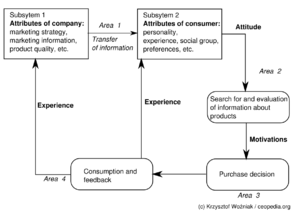Nicosia model
From CEOpedia | Management online
| Nicosia model |
|---|
| See also |
Nicosia model is a structural model of the purchase decision-making process by an individual consumer or a whole family.
This model shows the interactive relationship between the company and the consumer. They arise between them for mutual communication - company communicates with consumers through promotional activities, while consumers by making purchases.
The author of a model F.M. Nicosia identified three stages that gradually moves the consumer in process:
- preferences,
- attitudes,
- motivations.
The four areas of the decision-making process in Nicosia Model
In Nicosia Model the decision-making process is divided into four areas (graphically presented on fig. 1):
- Area 1 - includes consumer attitudes shaped by information from the market. In this area information flows from the source of their creation to the recipient.
- Area 2 - consumer is looking for information about specific products and gives them value. During the evaluation the consumer allocates appropriate weight to each information piece. When the result of the evaluation of a given product from the consumer's point of view is satisfactory, consumer is motivated to buy.
- Area 3 - act of purchase. Motivation - established in advance by consumer prompts him to acquire the product.
- Area 4 - feedback, as result of the consumption of the product, the consumer acquires a new experience and base on it his new preferences (predisposition). This last step is not only the consumption of a product but also a very important factor for the future decisions of the consumer. Feedback is also a very important factor for the company, which acquires a new information that could be used in preparing future product policy, its advertising and communications targeted to the consumer.
References
- F.M. Nicosia, Consumer Decision Processess; Marketing and Advertising Implications, Prentice Hall, Englewood Cliffs, N.J. 1966, s. 156.
- Bettman, J. R., & Jones, J. M. (1972). Formal models of consumer behavior: a conceptual overview. The Journal of Business, 45(4), 544-562.
- Bettman, J. R., Luce, M. F., & Payne, J. W. (1998). Constructive consumer choice processes. Journal of consumer research, 25(3), 187-217.
- Simonson, I., Carmon, Z., Dhar, R., Drolet, A., & Nowlis, S. M. (2001). Consumer research: In search of identity. Annual review of psychology, 52(1), 249-275.
